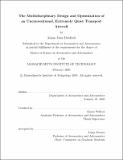| dc.contributor.advisor | Karen Willcox. | en_US |
| dc.contributor.author | Diedrich, Adam John, 1980- | en_US |
| dc.contributor.other | Massachusetts Institute of Technology. Dept. of Aeronautics and Astronautics. | en_US |
| dc.date.accessioned | 2005-09-26T15:53:05Z | |
| dc.date.available | 2005-09-26T15:53:05Z | |
| dc.date.copyright | 2005 | en_US |
| dc.date.issued | 2005 | en_US |
| dc.identifier.uri | http://hdl.handle.net/1721.1/27865 | |
| dc.description | Thesis (S.M.)--Massachusetts Institute of Technology, Dept. of Aeronautics and Astronautics, 2005. | en_US |
| dc.description | This electronic version was submitted by the student author. The certified thesis is available in the Institute Archives and Special Collections. | en_US |
| dc.description | Includes bibliographical references (p. 115-119). | en_US |
| dc.description.abstract | (cont.) aircraft. A design which utilized the results of the trade studies was presented and evaluated. The performance was reviewed in terms of aerodynamics, weight, economics, operations, and acoustics. The resulting design is compared with current commercial aircraft using the DOC model to evaluate how economically competitive the silent aircraft would be under current and potential future landing fee schedules. The comparison shows that a silent aircraft can achieve a DOC of approximately $0.056 per 3seat-nautical mile, nearly equal to the cost computed using the same model with data for the Boeing 747-400. When an aggressive landing fee schedule is assumed, where all current aircraft face increased landing fees due to noise, then the silent aircraft becomes economically dominant instead of just competitive, showing an approximate advantage of 19% when its DOC is compared with the 747-400 or any of various other current commercial transports operating under the more stringent fee schedule. | en_US |
| dc.description.abstract | This thesis describes the design, implementation, and use of an integrated design tool to predict and optimize the performance and costs associated with producing a novel, functionally silent commercial aircraft design. This tool is used to produce and evaluate an aircraft design, to evaluated trades between different potential missions and performance measures, and then to compare this low-noise design with current commercial aircraft. The nature of the integrated problem of designing for noise, which must take into account engine and airframe design, operational requirements, economics of airline operation, and noise generation, is described. A Blended-Wing-Body (BWB) configuration was selected for use as the basis for the silent aircraft platform due to its inherent potential for low-noise operations. This configuration was modeled using the design tools developed for the project as well as Boeing's WingMOD software. Both the design tools developed here and the WingMOD software are described. These models were used to perform design space trades with respect to aircraft range, cruise parameters, planform shape, acoustic performance, and engine performance requirements. The results of these trade studies were used to determine the performance cost of low noise configuration choices as well as the best mission and airframe constraints to apply to the silent aircraft. A Direct Operating Cost (DOC) model was developed from existing empirical relations. This DOC model was used to evaluate the cost of low noise designs and more stringent noise-based landing fees. It was also used to compare the silent aircraft with modern commercial aircraft to assess whether an aircraft designed with noise as an objective could be competitive with current | en_US |
| dc.description.statementofresponsibility | by Adam John Diedrich. | en_US |
| dc.format.extent | 119 p. | en_US |
| dc.format.extent | 1533557 bytes | |
| dc.format.extent | 1529609 bytes | |
| dc.format.mimetype | application/pdf | |
| dc.format.mimetype | application/pdf | |
| dc.language.iso | en_US | |
| dc.publisher | Massachusetts Institute of Technology | en_US |
| dc.rights | M.I.T. theses are protected by copyright. They may be viewed from this source for any purpose, but reproduction or distribution in any format is prohibited without written permission. See provided URL for inquiries about permission. | en_US |
| dc.rights.uri | http://dspace.mit.edu/handle/1721.1/7582 | |
| dc.subject | Aeronautics and Astronautics. | en_US |
| dc.title | The multidisciplinary design and organization of an unconventional, extremely quiet transport aircraft | en_US |
| dc.type | Thesis | en_US |
| dc.description.degree | S.M. | en_US |
| dc.contributor.department | Massachusetts Institute of Technology. Department of Aeronautics and Astronautics | |
| dc.identifier.oclc | 60494069 | en_US |
